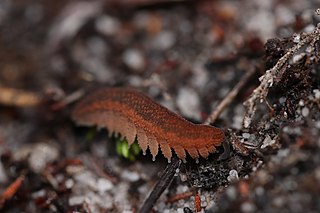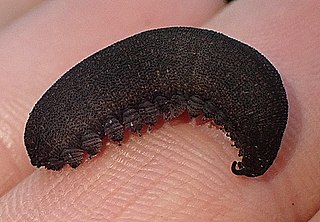
Peripatoides suteri is a species of velvet worm in the family Peripatopsidae. Like all other species in the genus Peripatoides, this species is ovoviviparous and endemic to New Zealand. This species is notable for featuring 16 pairs of legs, unlike all other species of Peripatoides, which have only 15 leg pairs. This species has more legs than any other species of velvet worm found in New Zealand.

Peripatopsis is a genus of velvet worms in the Peripatopsidae family. These velvet worms are found in the KwaZulu-Natal, Western Cape, and Eastern Cape provinces of South Africa. This genus was proposed by the British zoologist Reginald I. Pocock in 1894 with Peripatopsis capensis designated as the type species.
Metaperipatus is a genus of velvet worms in the family Peripatopsidae that contains two species found in Chile, including Metaperipatus inae. This genus was created by the American zoologist Austin Hobart Clark in 1913 to contain the type species, M. blainvillei. Authorities believe M. blainvillei is a species complex, however, and some consider M. blainvillei a nomen dubium.
Opisthopatus amaxhosa is a species of velvet worm in the family Peripatopsidae. This species is a clade in the O. cinctipes species complex. This species has 16 or 17 pairs of legs in both sexes and varies from light to dark pink on the dorsal surface and from dark to light brown on the ventral surface. Males of this species range from 12 mm to 14 mm in length. Also known as the Xhosa velvet worm, this species is found in the Eastern Cape province in South Africa.
Opisthopatus swatii is a species of velvet worm in the family Peripatidae. This species is a clade in the O. cinctipes species complex. This species has 16 pairs of legs, and the color of the dorsal surface ranges from blue to slate black, while the ventral surface ranges from light brown to creamy white. The original description of this species is based on male holotypes ranging from 13 mm to 20 mm in length. Also known as the Swati velvet worm, this species is found in indigenous forest patches along the Highveld in Mpumalanga province in South Africa.
Peripatopsis balfouri is a species of velvet worm in the Peripatopsidae family. This species has 18 pairs of clawed legs. Also known as the blue velvet worm, this species ranges from 9 mm to 22 mm in length. The type locality is in South Africa.
Peripatopsis birgeri is a species of velvet worm in the family Peripatopsidae. This species is a clade in the P. moseleyi species complex. The number of legs in this species varies from 21 pregenital pairs to 22 pregenital pairs. Live animals are light green, brown, or black with a distinct pale head collar; the ventral surface is creamy white. Males range from 23 mm to 40 mm in length; females range from 28 mm to 40 mm in length. Also known as the Mount Currie velvet worm, this species is known only from the Mount Currie Nature Reserve in South Africa.
Peripatopsis hamerae is a species of velvet worm in the family Peripatopsidae. This species is a clade in the P. moseleyi species complex. The original description of this species is based on one specimen of each sex, each measuring 22 mm in length with a black dorsal surface and creamy white ventral surface. The male of this species has 22 pairs of pregenital legs and one pair of genital legs; the female has 23 pairs of pregenital legs and one pair of genital legs. Also known as the Kamala velvet worm, this species is known only from Groot Bruintjieshoogte in South Africa.
Peripatopsis janni is a species of velvet worm in the family Peripatopsidae. This species is a clade in the P. moseleyi species complex. The original description of this species is based on male specimens ranging from 15 mm to 30 mm in length. Live animals are dark green on the dorsal surface but greyish white on the ventral surface. The number of legs in males of this species varies from 21 pregenital pairs to 22 pregenital pairs. Also known as the Amathole velvet worm, this species is found in the Amathole mountains in South Africa.

Peripatopsis lawrencei is a species of velvet worm in the Peripatopsidae family. This species has 17 pairs of legs, with the last pair reduced in size but featuring two claws on each leg. This species is restricted to the Theewaterskloof-Overstrand region of South Africa.

Peripatopsis moseleyi is a species of velvet worm in the Peripatopsidae family. Males of this species have 20 to 24 pairs of legs with claws ; females have 19 to 23 pairs of legs with claws. Females range from 11 mm to 75 mm in length, whereas males range from 9 mm to 50 mm. The type locality is in South Africa.
Peripatopsis sedgwicki is a species of velvet worm in the Peripatopsidae family. Also known as the Tsitsikamma velvet worm, this species has a narrow geographic distribution in South Africa but is especially abundant in the indigenous forest of the Tsitsikamma mountains. Recent phylogenetic analysis using molecular data finds that Peripatopsis sedgwicki as traditionally understood based on morphology is a species complex that contains four different species: P. sedgwicki s.s., P. orientalis, P. collarium, and P. margaritarius.
Peripatopsis purpureus is a species of velvet worm in the family Peripatopsidae. This species is a clade in the P. balfouri species complex. Males of this species have 17 clawed legs with the last pair highly reduced, whereas females have a complete foot with claws on the reduced leg. Specimens range from 17 mm to 25 mm in length. Named for its purple-blue color, this species is found in the Western Cape Province of South Africa.
Peripatopsis storchi is a species of velvet worm in the family Peripatopsidae. This species is a clade in the P. moseleyi species complex. The number of legs in this species ranges from 21 pregenital pairs to 23 pregenital pairs. Males of this species range from 12 mm to 22 mm in length, and females range from 22 mm to 36 mm in length, but live animals can stretch to 50 mm while walking. Also known as the Katberg velvet worm, this species is known only from the Katberg forest in South Africa.

Peripatopsis alba, the white cave velvet worm, is a species of velvet worm in the family Peripatopsidae. This species is notable as one of only two species of velvet worm known to be troglobitic; the only other velvet worm known to be a troglobiont is Speleoperipatus spelaeus. The white cave velvet worm is rare and limited to one cave system on Table Mountain in South Africa.

Peripatopsis clavigera, the Knysna velvet worm, is a species of velvet worm in the Peripatopsidae family. This species has 16 pairs of legs and ranges from 4 mm to 17 mm in length. Peripatopsis clavigera is found in subtropical or tropical moist montane forests of the Diepwalle Nature Reserve in South Africa.
Opisthopatus camdebooi is a species of velvet worm in the family Peripatopsidae. Also known as the Camdeboo velvet worm, this species is endemic to the Camdeboo National Park in South Africa. This species is notable for adapting to an unlikely environment for the survival of velvet worms. This species was found in soil 30 cm beneath the surface in the Valley of Desolation in Camdeboo National Park in the Great Karoo, an arid region devoid of forests. Over millions of years, this velvet worm apparently adapted to an increasingly arid Karoo basin by taking refuge at higher altitudes and adopting a mode of life underground but near the surface. This species is the first velvet worm discovered in South Africa with such a near-surface mode of life.
Peripatopsis aereus is a species of velvet worm in the family Peripatopsidae. This species is known only from the Riviersonderend Mountains in South Africa. This velvet worm was discovered living in sympatry with another species in the same genus, P. lawrencei. These two sympatric species can be distinguished based on the number of legs: The species P. aereus has 18 pairs of legs, whereas the species P. lawrencei has only 17 leg pairs.
Peripatopsis collarium is a species of velvet worm in the Peripatopsidae family. This velvet worm is a point endemic known only from a small sample found in the Van Stadens Wild Flower Reserve in South Africa. The species name of P. collarium refers to a distinctive white head collar present in all specimens of this velvet worm. This species was discovered as a clade within the Peripatopsis sedgwicki species complex.
Peripatopsis orientalis is a species of velvet worm in the Peripatopsidae family. This species was discovered as one of four clades within the Peripatopsis sedgwicki species complex. Each clade represents a separate species, each with a different geographic distribution in South Africa. The species P. orientalis has the broadest distribution among the four species in this species complex. The specific name refers to the relatively eastern distribution of this species within this species complex.





